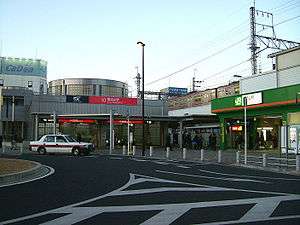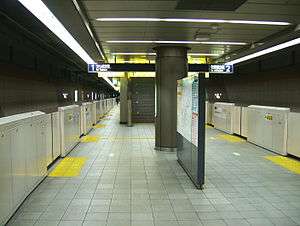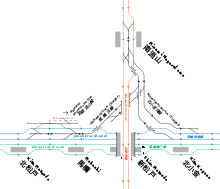Minami-Nagareyama Station
Minami-Nagareyama Station (南流山駅, Minami-Nagareyama-eki) is a railway station in Nagareyama, Chiba, Japan, operated by both East Japan Railway Company (JR East) and Metropolitan Intercity Railway Company. The station is number 10 on the Tsukuba Express line.
Minami-Nagareyama Station 南流山駅 | |
|---|---|
 Station entrance, January 2008 | |
| Location | Minami-Nagareyama, Nagareyama, Chiba (千葉県流山市南流山) Japan |
| Operated by | |
| Line(s) | |
| Connections |
|
Lines
Minami-Nagareyama Station is served by the orbital Musashino Line, which runs between Fuchūhommachi and Tokyo, and by the Tsukuba Express line, which runs from Akihabara in Tokyo and Tsukuba in Ibaraki Prefecture. It is located 55.4 kilometers from Fuchūhommachi Station on the Musashino Line, and 22.1 kilometers from Akihabara Station on the Tsukuba Express.
Station layout
JR East
JM16 Minami-Nagareyama Station 南流山駅 | |
|---|---|
| JR East station | |
 Musashino Line platforms, June 2008 | |
| Location | 1–25 Minami-Nagareyama, Nagareyama City, Chiba Prefecture Japan |
| Operated by | JR East |
| Line(s) | JM Musashino Line |
| Platforms | 2 side |
| History | |
| Opened | 1973 |
| Traffic | |
| Passengers (FY2014) | 31,029 daily[1] |
The JR East station consists of two elevated opposed side platforms serving two tracks, with a bi-directional centre track used for freight services. The station building is located underneath the platforms.
Platforms
| 1 | JM Musashino Line | for Minami-Koshigaya, Musashi-Urawa, and Fuchūhommachi |
| 2 | JM Musashino Line | for Nishi-Funabashi, Tokyo, and Kaihimmakuhari |
Tsukuba Express
Minami-Nagareyama Station 南流山駅 | |
|---|---|
| Tsukuba Express station (underground) | |
 Tsukuba Express platforms, January 2008 | |
| Location | 2–1 Minami-Nagareyama, Nagareyama, Chiba (千葉県流山市南流山二丁目1) Japan |
| Operated by | Metropolitan Intercity Railway Company |
| Line(s) | Tsukuba Express |
| Other information | |
| Station code | 10 (TX) |
| History | |
| Opened | 2005 |
| Traffic | |
| Passengers (FY2014) | 31,904 daily |
The Tsukuba Express station consists of an underground island platform serving two tracks. The platforms were approximately 125 m long when built, to accommodate 6-car trains.[2]
Platforms
| 1 | ■ Tsukuba Express | for Nagareyama-Ōtakanomori, Moriya, and Tsukuba |
| 2 | ■ Tsukuba Express | for Misato-chūō, Kita-Senju, and Akihabara |

Adjacent stations
| « | Service | » | ||
|---|---|---|---|---|
| Musashino Line JM16 | ||||
| Misato JM17 | Shimōsa | Shim-Matsudo JM15 | ||
| Misato JM17 | Local | Shim-Matsudo JM15 | ||
| Tsukuba Express (10) | ||||
| Kita-Senju (05) | Rapid | Nagareyama-Ōtakanomori (12) | ||
| Yashio (08) | Commuter Rapid | Nagareyama-Ōtakanomori (12) | ||
| Misato-chūō (09) | Semi Rapid | Nagareyama-Ōtakanomori (12) | ||
| Misato-chūō (09) | Local | Nagareyama-centralpark (11) | ||
History
Minami-Nagareyama Station opened on 1 April 1973.[3]
The Tsukuba Express station opened on 24 August 2005, coinciding with the opening of the line.
The Tsukuba Express platforms are scheduled to be lengthened by 40 m in either direction by autumn 2012 to allow the train stopping positions to be offset, thus reducing platform crowding during peak periods.[2]
Surrounding area
- Toyo Gakuen University Nagareyama Campus
- Nagareyama Post Office
See also
![]()
References
- 各駅の乗車人員 (2014年度) [FY2014 Station passenger figures] (in Japanese). Japan: East Japan Railway Company. Retrieved 2 February 2016.
- 3編成18両の車両増強と南流山駅ホーム改良計画について [Details of new build of 3 trainsets and platform improvements at Minami-Nagareyama Station] (PDF). Tsukuba Express News Release (in Japanese). Metropolitan Intercity Railway Company. 11 January 2011. Archived from the original (PDF) on 6 March 2012. Retrieved 12 January 2011.
- "JR East station information" (in Japanese). East Japan Railway Company. Retrieved 12 January 2011.